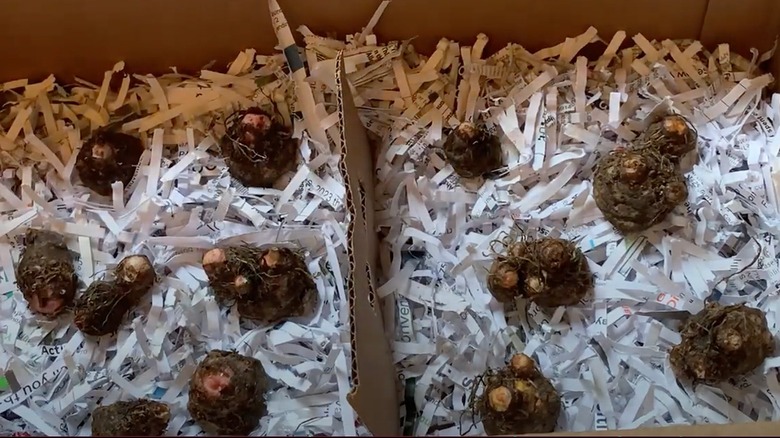Don't Toss Shredded Paper - Save It For This Clever End-Of-Season Garden Hack
Most people shred unwanted mail and other documents for security reasons, but what do you do with the resulting pile of paper? You don't want to toss it, and many recycling depots won't accept it anyway. Besides, why waste what's potentially worth its weight in gold? Garden gold, to be precise. That "trash" is actually the perfect material to protect your spring bulbs through winter. There are plenty of other equally creative ways to repurpose shredded paper to use in your home and garden, but for backyard alchemists, this end-of-season garden hack is ideal.
Rather than spending ages rooting around for adequate storage options, nestling your precious bulbs in the shredded paper you already have on hand not only saves time and money – it's dry, breathable, and provides insulation. Plus, it ups your eco-warrior status because you're not adding to the landfill. The bulbs sit snugly in place without bumping into one another and the absorbent paper ensures they remain dry, thereby keeping fungus at bay and minimizing the chances of spreading disease or succumbing to rot.
Before you start shredding, it's important to note that not all paper is garden friendly. Generally speaking, anything that's pure paper is fine (newspaper, office documents, etc.) while paper that's glossy or coated is not, so make sure you separate those out before you get started. If you have more paper than you need, some people use shredded paper as garden mulch.
How to store bulbs using shredded paper
Storing your bulbs using shredded paper is a breeze. Once you've decided which plants you'd like to save, you'll need to dig them up, brush off the excess soil, and leave them to dry out for about 14 days. You've already got your bulbs' bedding, so the next step is to find them a comfy bed. A paper bag or cardboard box are good options. Both are breathable, which is important for air circulation. They're also easy to come by and earth-friendly.
Grab your stash of shredded garden gold, add a generous layer, and place your prepared bulbs in their winter home. They should be nicely ensconced but not touching one another. Finally, you'll need to close the box or bag, label it with the date and type of bulb, and place it in a cool, dry location away from sunlight — ideally between 35 and 50 degrees Fahrenheit. Apart from checking in on them from time to time, your job is done.
You may be wondering how long you can leave your bulbs in their cosy hibernation digs. It really depends on the type of bulb, since some are hardier than others, but in general, most bulbs can endure about 12 months in storage before you'll need to plant them. That said, they're happiest when planted within six months, when you can utilize the must-know bulb planting tips from our expert gardener. And, if you're like most gardeners, you'll be equally happy knowing your beds will soon be a riot of color.

